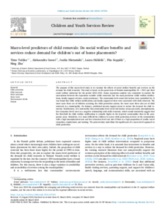The purpose of this macro-level study is to examine the effects of social welfare benefits and services on the demand for child removals. The study is based on the panel data of Finnish municipalities (N = 293) and their social welfare indicators for the period 2010–2021. Linear regression analysis was conducted to analyze the associations between the dependent variable (child removals) and the main predictors (child welfare notifications, family support services, social assistance).
The community-level social risk factors were controlled for. It was found that child welfare notifications and family support services were associated with child removals. The more cases there are of children accessing the child protection system, the more cases there also are of child removals in a municipality. On balance, additional income support seems to reduce the demand for child removals.
Furthermore, it is noteworthy that community-level social risk factors (drop-out youth, unemployment, low education level) were in a negative relationship with child removals, which would tentatively suggest that the threshold for child welfare notifications is actually higher in the deprived communities than in the prosperous areas. Relatively, it is more difficult for children to access child protection services in the communities with a high unemployment rate and low education level and also if there is a high proportion of youths out of education, employment, and training. The present study underlines the significance of a macro-level approach to child protection.

